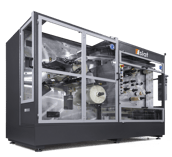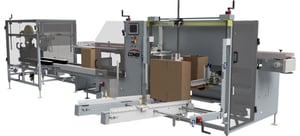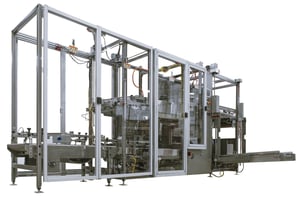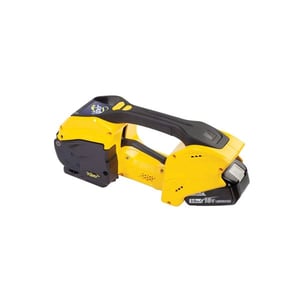Copyright 2015 PMMI Media Group, Inc. All rights reserved. This article from the December 2014 issue of Packaging World® (www.packworld.com) is reprinted by permission of PMMI Media Group Inc. Packaging World® is a registered trademark of PMMI Media Group, Inc.
You may not be able to teach an old dog new tricks. But Big Heart Pet Brands is teaching dog owners to improve dental hygiene in dogs young and old by putting Milk-Bone Brushing Chews in packaging that mimics a toothpaste carton.
Finding the equipment that would make such a package possible was no easy task. But San Francisco-based Big Heart Pet Brands not only succeeded, they also snagged the PMMI Packaging Line of the Year in the process. Presented annually at PACK EXPO, this is the packaging community’s most prestigious recognition of packaging line innovation and excellence.
To create its winning line, Big Heart Pet Brands enlisted the cooperative efforts of a series of packaging machinery companies, including Kliklok-Woodman, which entered the line into the competition. The line occupies the facility of a contract packager that Big Heart has worked with on a number of previous projects.
Traditionally most of Big Heart Pet Brands’ other treats have been packaged in stand-up pouches. When the company decided to enter the dental dog treat category with Milk-Bone Brushing Chews at-home dental treats, the stand-up pouch was considered the way to go. But Senior Manager of Packaging R&D Paul Baker wanted to take a different approach. He thought it would be a good idea “to design the packaging for the desired consumer experience.” But change isn’t easy.
“Part of the roadblock was getting people to realize that if we put this into a stand-up pouch, it would disappear on the shelf and the customer would never see it,” Baker says. “What we needed was a package that would not only let the consumer know right away that this was a dental product, but that would also cue them to associate their dog’s dental routine with their own.”
Enter the idea for a toothpaste carton with a pouch of treats inside, a concept that Baker’s colleagues came to like very much. Executing on the concept, however, was no walk in the park, largely because the design called for a carton that opened and relocked across a horizontal front panel as opposed to the conventional tuck ends that toothpaste cartons have had from time immemorial. The package looked great, but Baker could not find a builder of carton closing equipment willing to tackle such a carton. Get rid of the relocking horizontal front panel, he was told repeatedly, and give it more conventional tuck ends. “I couldn’t find or convince anybody to build a piece of equipment to close carton for me,” Baker says.
Even when RockTenn Co. joined the project—first with help on prototyping and then as carton producer—still Baker struggled to find a vendor who would custom-design the complementary machinery. “Every which way to Sunday, we were trying to find a vendor to meet our needs,” Baker says. “RockTenn thought they had a machine builder lined up, but that OEM turned us down once they realized what it was we were proposing.”
Tired of proverbial doors slamming in his face, Baker and Engineer Roy Greengrass decided to take their prototype to PACK EXPO International 2012 and sit down face-to-face with as many suppliers as it would take to get the project off the ground. Due to the secretive nature of the Milk-Bone brand entering a category it had not previously been in, Baker had the mock-up hidden in his backpack as he walked up and down the aisles of McCormick Place.
After visiting more than a dozen suppliers at the show, Baker found himself at the Kliklok-Woodman booth. He was prepared to hear the same thing he’d been hearing all along: that he needed to abandon the idea of a toothpaste carton having a horizontal relocking front panel. Instead he encountered Sales Account Manager Gary Akin, who saw some similarities between the carton Baker was proposing and what Akin called a “hood-covered” carton that Kliklok-Woodman’s equipment had handled in the past for donuts. What Baker also encountered at the Kliklok-Woodman booth was a willingness to sit down and work out how best to come up with machinery that would do what Big Heart Pet Brands wanted, even if it involved custom engineering. The result was a special Kliklok-Woodman Vari-Pitch Flip Top carton closer. Also selected by Baker for the line were two Kliklok-Woodman ECT-625 carton erectors.
Baker says the carton erectors are pretty standard offerings from Kliklok-Woodman, though he does emphasize that he’s pleased with how readily change parts can be added to or removed from the carton erectors when it’s time to switch among the three net weights run on the line: 5.5-, 14.14-, and 22.0-oz. But it’s the carton closer he’s especially impressed with, because there are a few things about the carton design that required some customizing when it came to the closer. For one thing, getting the two relocking tabs to fold over out of the way was something Kliklok-Woodman had to resolve mechanically. Another challenge was the small size of the 5.5-oz carton. “There are fingers and gears in the base model on which our closer was built, but the base model hadn’t encountered a carton as small as this,” says Baker. “So Kliklok had to compress that space down quite a bit.” The team also expected that the beveled front of the carton was going to cause problems, but it turned out that it didn’t.
As for the carton itself, it’s a metallized polyester adhesive laminated to an 18-pt SBS. This laminated structure is then printed by RockTenn on a 10-color flexo press. “Remember, the whole idea was to make it look as much like a toothpaste carton as possible,” says Baker. “We really wanted to communicate ‘dental,’ and this package—from its graphics to the colors selected to the metallization—gets that message across very quickly.”
Two distinctive features in the design of the carton should be pointed out. First, the image of the Milk-Bone itself on front and back panels, the image of the toothbrush on the back panel, and everywhere the iconic Milk-Bone logo appears—these are all embossed. Second, just above the main front panel is a beveled white panel that says “ADVANCED ORAL CARE.”
Even with his carton closing issues resolved, Baker wasn’t out of the woods yet. Primary packaging also had to be addressed, as the task of putting the chew bones into a pouch was no simple feat.
Baker knew he wanted a doy style pouch inside the toothpaste carton and tried three different makers of combination scales who could properly deliver the bones to the bagger. Baker’s research into makers of combination scales paid off when he learned that Ishida, through Heat and Control, would be able to custom build a combination scale that would do the trick.
With the scale provider identified, Baker now had to find a vertical form/fill/seal system capable of creating the bag styles he sought. This machine he got through Bosch Packaging Technology, and once again it involved some custom design work.
In the finished line, three scales sit above three baggers. Heat and Control FastBack horizontal conveyors carry the dental chews from bulk shippers to a bucket elevator leading to an overhead mezzanine where the three Ishida combination scales sit. This bucket elevator discharges the product onto another FastBack horizontal conveyor that distributes the dental chews evenly to the three Ishida combination scales.
The primary packaging material used for the new brushing chews is supplied by Printpack and comes in two varieties. For the small carton, which holds a net weight of 5.5 oz, the material is a polyester-based multilayer extrusion lamination. For the two larger cartons, nylon is substituted for polyester. “As we go up in weight we find we need a slightly more robust structure, and the nylon gives us that,” says Baker.
Also quite different are the bags themselves and the way they’re made on the Bosch vf/f/s machines. What all three bags have in common is that each has a re-sealable packaging closure system based on self-mating micro hooks. The 5.5-oz bag has a VelcroPRESS-LOK re-closeable fastener applied right on the Bosch Packaging machine. The Velcro component is applied in the machine direction, so the orientation of the bag as it moves through the Bosch system is the same as what’s shown by the bag on the far left of Photo A. The result is a bottom-gusseted doy-style bag.
The two larger bag sizes had to be a different style in order to fit all the bone chews in, says Baker. “What we needed was not a bottom-gusseted doy-style but rather a side-gusseted flat-bottom bag (see bag on the far right of Photo A). But to make a side-gusseted flat-bottom bag on the Bosch machine, the re-closure feature has to be applied not in the machine direction but across the machine direction, or transversely. Bosch didn’t have a way to do that at the time. So we went with a pre-applied re-closure feature. Velcro, at the time, couldn’t supply us with a closure that we could have pre-applied. Aplix did. So that’s the direction we took.”
The way it works now for the two larger bag sizes is that Valley Packaging Supply Co. uses a Hudson Sharp fixture to apply the Aplix EASY-LOCK re-sealable packaging closure system to the Printpack rollstock. Valley Packaging then ships to the contract packager rolls of film that have the Aplix EASY-LOCK closure system pre-applied.
Downstream from each Bosch machine is a checkweigher/metal detector from Ishida. Bags then move along conveyors from Shuttleworth, a Pro Mach Division, so they can be placed in cartons that have been erected by the two Kliklok-Woodman ECT-625 carton erectors. Each carton erector is followed by a Valco Melton unit that puts a bit of adhesive down so that primary packs can be held stationary inside the carton.
Next is carton closing, done by the Kliklok-Woodman Vari-Pitch Flip Top carton closer discussed above. Empty cartons move from the erector to the closer on conveyors from Kleenline, a Pro Mach division. Cartons exiting the closer are coded with lot and date code and other variable information by a laser coder from ID Technology, also a Pro Mach division.
Closed cartons are conveyed to a robotic case packer from Combi Packaging Systems that receives cases from a Combi case erector. Also from Combi is the case taper that closes the cases. A Domino ink jet printer brings the line to a close, before palletizing.
The entire process—from Baker attending PACK EXPO through the picking of vendors and equipment delivery to startup of the packaging line—took a little over a year. Big Heart Pet Brands did the design work and served as the overall integrator.
Perhaps most important to Big Heart Pet Brands is that the package has proven to be a big winner in the marketplace. With 75 million bones sold and the product on pace to do $70 million in retail sales in its first year, Milk-Bone Brushing Chews represents one of the most impressive product launches in recent memory. It also received the Grocery Manufacturers Association CPG Award for Innovation and Creativity, one of the most prestigious awards in the consumer packaged goods industry.
| For article and video of this line in action, please visit: http://www.packworld.com/machinery/cartoning/healthy-rewards-big-heart-pet-brands |
To discuss introducing a Combi case packing system to your production line, call 800-521-9072 or contact us.

.png?width=172&name=End%20of%20Year%20Sale%20Equip%20Drop%20Down%20(172%20x%20157%20px).png)






.png?width=161&name=ProWrap%20(1).png)


